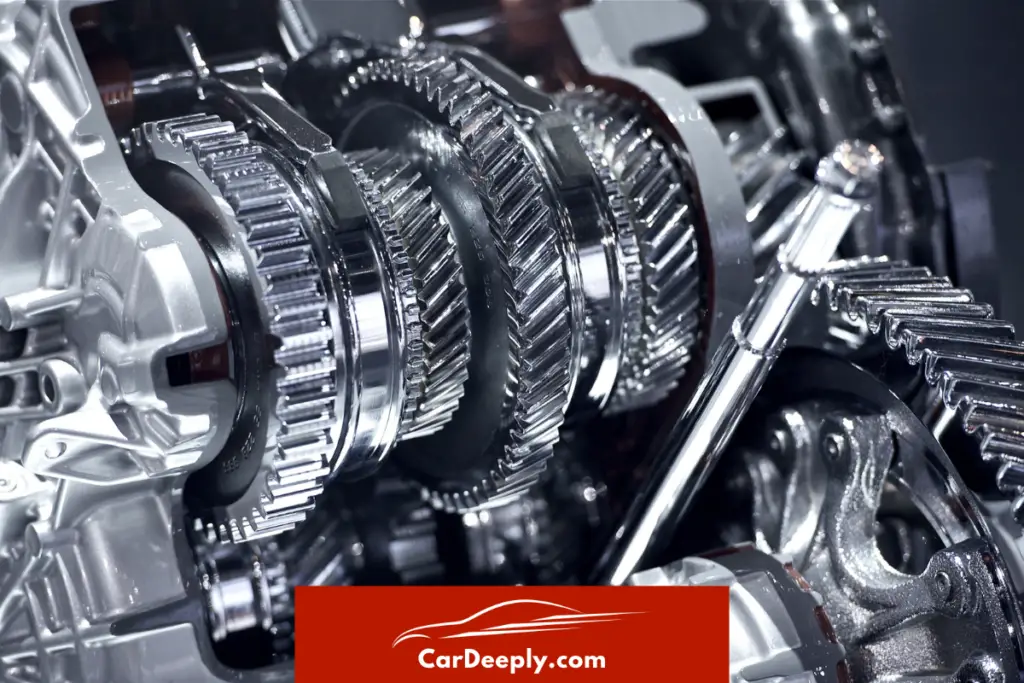Ever found yourself scratching your head over the terms ‘gearbox’ and ‘transmission’?
You’re not alone!
Dive into this comprehensive guide and save yourself from common misconceptions. We’re about to unravel the mystery behind these two crucial components of your vehicle.
By the end, you’ll not only understand the difference between a gearbox and a transmission, but you’ll also be able to impress your friends with your newfound knowledge.
Let’s get started!
Advertising links are marked with *. We receive a small commission on sales, nothing changes for you.
Key Takeaways

- A gearbox, often called a gearhead or gear reducer, is a mechanical device that uses gears and gear trains to provide speed and torque conversions from a rotating power source to another device.
- Several gearboxes, including manual, automatic, continuously variable transmission (CVT), automated manual/semi-automatic, and dual-clutch, each serving a unique purpose.
- The transmission is the mechanism that transmits power from the engine to the wheels of a motor vehicle. It comprises several components, including the clutch, gearbox, differential, and final drive shafts.
- While the gearbox and transmission are part of the same system and work together, they have distinct functions and roles in a vehicle.
- Regular maintenance of both the gearbox and transmission is crucial for the optimal performance of your vehicle, and problems with one can affect the other.
Comparing Gearbox and Transmission
Before we dive into the comparison, it’s important to remember that while the gearbox and transmission are part of the same system, they have distinct functions and roles.
So here’s a quick comparison to help you understand their differences:
| Gearbox | Transmission | |
|---|---|---|
| Definition | A mechanical device that uses gears and gear trains to provide speed and torque conversions from a rotating power source to another device. | The mechanism that transmits power from the engine to the wheels of a motor vehicle. |
| Components | Contains gears and gear trains. | Consists of several components, including the clutch, gearbox, differential, and final drive shafts. |
| Function | Changes the speed of the motor, allowing an output of torque and speed determined by the gear ratio. | Transmits the power generated by the engine to the driving wheels and propeller. |
| Types | Manual, Automatic, CVT, Automated Manual/Semi-Automatic, Dual-Clutch | N/A |
| Role in a Vehicle | Reduces the speed of the input shaft to create higher torque on the output shaft. | Transmits the power from the engine to the wheels. |
Understanding the Gearbox: A Key Component of Your Vehicle
Ever wondered what makes your car move smoothly from one speed to another? That’s where the gearbox comes in.
It’s a crucial part of your vehicle that you might not think about often, but it plays a significant role in your car’s performance.
What Exactly is a Gearbox?
A gearbox, often called a gearhead or gear reducer, is a mechanical device that uses gears and gear trains to provide speed and torque conversions from a rotating power source to another device.
In simpler terms, it’s part of your car that changes the speed of the motor, allowing an output of torque and pace determined by the gear ratio.
Different Types of Gearboxes
There are several types of gearboxes, each serving a unique purpose. Let’s take a look at some of them:
Manual Gearbox: This type requires the driver to shift gears using a clutch manually. It gives the driver more control over the vehicle’s power.
- Automatic Gearbox: This type allows the driver to switch from park to drive or reverse without using a clutch. It has different gear ratios, providing the engine with more power.
- Continuously Variable Transmission (CVT): Similar to an automatic gearbox, it doesn’t have fixed ratios. Instead, it uses a steel drive belt between two pulleys to adjust the gear ratios based on the vehicle’s speed.
- Automated Manual/Semi-Automatic Gearbox: This type is like an automatic transmission but uses a clutch to change gears instead of a torque converter.
- Dual-Clutch Gearbox: Also known as DSG, PDK, and Power-shift, this type has two clutches, each responsible for either even-numbered gears or odd-numbered gears.
The Role of a Gearbox in a Vehicle
The gearbox is the transmission system’s second stage, located after the clutch and bolted to the backside of the engine. It plays a crucial role in reducing the speed of the input shaft to create higher torque on the output shaft.
This means that a small power source, like an engine, can achieve higher torque than the output of the power source.
Now that we’ve covered the basics of a gearbox let’s move on to another vital component of your vehicle – the transmission.
Transmission: The Powerhouse of Your Vehicle
The transmission is often defined as the mechanism that transmits power from an engine to the wheels of a motor vehicle.
In other words, the component allows power transfer from one spot to another.
Components of a Transmission
A transmission comprises several components: a clutch, gearbox, differential, and final drive shafts.
Each of these parts plays a unique role in ensuring the smooth operation of your vehicle.
The Role of a Transmission in a Vehicle
The transmission’s primary role is to transmit the power generated by the engine to the driving wheels and propeller.
It does this by reducing the speed of the input shaft to create higher torque on the output shaft. This allows a small power source, like an engine, to achieve higher torque than the output of the power source.
In conclusion, the gearbox and transmission are vital components of your vehicle. Understanding their functions and differences can help maintain your vehicle and ensure its optimal performance.
Distinguishing Between Gearbox and Transmission
Now that we have a solid understanding of what a gearbox and a transmission are let’s delve deeper into their relationship and how they differ.
The Intricate Relationship Between Gearbox and Transmission
The gearbox and transmission are like two sides of the same coin. They work hand in hand to ensure your vehicle runs smoothly.
The gearbox is a part of the transmission system, and it’s responsible for housing the gears that change the speed of the motor.
On the other hand, the transmission is the mechanism that transmits power from the engine to the wheels of your vehicle.
However, it’s important to note that problems with one can affect the other. For instance, if the gearbox goes bad, it can put more strain on the transmission, leading to potential damage.
Similarly, issues with the transmission can also impact the gearbox. That’s why regular maintenance of both components is crucial for the optimal performance of your vehicle.
Key Differences Between Gearbox and Transmission
While the gearbox and transmission are closely related, they have distinct functions and roles in a vehicle.
Here are some key differences:
Function and Structure
The gearbox is the part of the transmission that contains the gears. It’s responsible for changing the speed of the motor, allowing an output of torque and speed determined by the gear ratio.
The gearbox can be manual, automatic, or semi-automatic, each serving a unique purpose.
On the other hand, the transmission is the mechanism that transmits power from the engine to the wheels. It comprises several components, including the clutch, gearbox, differential, and final drive shafts.
Roles in a Vehicle
The gearbox plays a crucial role in reducing the speed of the input shaft to create higher torque on the output shaft. This allows a small power source, like an engine, to achieve higher torque than the output of the power source.
On the other hand, the transmission transmits the power generated by the engine to the driving wheels and propeller. So it’s the middleman between the engine and the wheels, ensuring the smooth operation of your vehicle.
In conclusion, while the gearbox and transmission are part of the same system and work together, they have distinct functions and roles. Understanding these differences can help maintain your vehicle and ensure its optimal performance.
Frequently Asked Questions
How often should I service my gearbox and transmission?
Regular maintenance is crucial for your vehicle’s gearbox and transmission longevity. Typically, it’s recommended to have your transmission fluid checked and changed every 30,000 to 60,000 miles.
However, this can vary depending on your vehicle’s make and model, so it’s best to consult your vehicle’s manual or a professional mechanic.
What are the signs of a failing gearbox or transmission?
Common signs of a failing gearbox or transmission include unusual noises like whining or clunking, difficulty shifting gears, a burning smell, fluid leakage, and a check engine light. If you notice any of these signs, it’s advisable to get your vehicle checked by a professional immediately.
Can I drive with a faulty gearbox or transmission?
Driving with a faulty gearbox or transmission can be dangerous and cause further damage to your vehicle. If you suspect a problem, having your car inspected by a professional as soon as possible is best.
What’s the difference between a manual and automatic gearbox?
The main difference between a manual and automatic gearbox is how gears are changed. In a manual gearbox, the driver manually shifts gears using a clutch. In contrast, an automatic gearbox changes gears automatically without the driver needing to use a clutch.
How does the gearbox affect fuel efficiency?
The gearbox plays a significant role in your vehicle’s fuel efficiency. It ensures that the engine operates at an optimal speed, reducing fuel consumption. However, a faulty gearbox can lead to increased fuel consumption, highlighting the importance of regular maintenance.
Wrapping Up: Gearbox and Transmission Unraveled
We’ve journeyed through the intricate world of gearboxes and transmissions, unraveling their mysteries and highlighting their unique roles in your vehicle’s performance.
Remember, these components are not just ‘car parts.’ They are the heart and soul of your vehicle’s movement and power. Therefore, understanding their functions, differences, and interdependence is crucial for car owners.
In addition, it empowers you to make informed decisions about vehicle maintenance and troubleshooting.
So, the next time you’re behind the wheel, remember the incredible engineering working seamlessly beneath you, making your journey smooth and enjoyable.

Sebastian loves convertibles and drove a BMW 335i for a long time (325 hp is just a dream). Today, with two children, he is more concerned with SUVs and family-friendly vehicles. In addition to an Audi A4 Avant, he also drives a Cupra Formentor VZ – even as a family man, you can’t do without speed. Get to know Sebastian better and visit the About Us page.
Advertising links are marked with *. We receive a small commission on sales, nothing changes for you.

